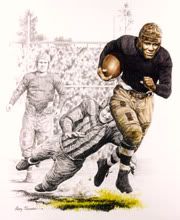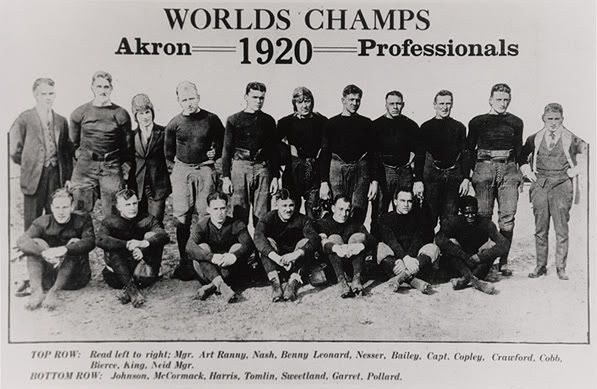 Browns Archive
Browns Archive  Meet the Akron Pros: First Champions of the NFL
Meet the Akron Pros: First Champions of the NFL
 Forty-four years ago, when the NFL and AFL’s illicit affair birthed the Super Bowl, pro football in America essentially hit the reset button. The game’s new crowning jewel proved so bright that, as a consequence, nearly half a century of pre-merger history was cast in a permanent shadow—acknowledged, but statistically bordering on irrelevant. This is why it sometimes seems like only Northeast Ohio still remembers the Cleveland Browns’ four NFL Championships of the ‘50s and ‘60s. And it’s also why virtually no one—including Northeast Ohioans—remember the Akron Pros: first ever World Champions of the NFL.
Forty-four years ago, when the NFL and AFL’s illicit affair birthed the Super Bowl, pro football in America essentially hit the reset button. The game’s new crowning jewel proved so bright that, as a consequence, nearly half a century of pre-merger history was cast in a permanent shadow—acknowledged, but statistically bordering on irrelevant. This is why it sometimes seems like only Northeast Ohio still remembers the Cleveland Browns’ four NFL Championships of the ‘50s and ‘60s. And it’s also why virtually no one—including Northeast Ohioans—remember the Akron Pros: first ever World Champions of the NFL.To be fair, only a handful of people are even capable of actually “remembering” the Akron Pros. The team, originally known as the Akron Indians, was formed in 1908 as part of the semi-pro Ohio League. Smalltime as that may sound, keep in mind that the Cuyahoga River is basically the Tigris and Euphrates of pro football—the birthplace of the sport in its modern form. Thus, by no coincidence, the Indians featured many of the top talents in the Midwest, including a slew of ex-Notre Dame stars—Knute Rockne among them. Akron had some pretty fierce Ohio League rivalries during the 1910’s with squads like the Massillon Tigers (not the high school) and the Jim Thorpe-led Canton Bulldogs, but the club was mostly down on its luck by the end of the 1919 season.
A year later, various team owners gathered in Canton for a meeting that continues to produce shockwaves 90 years after the fact. Ironically, it was a barely press-worthy event at the time, but when the meeting adjourned, the Akron Indians-- renamed the Pros-- were officially included among the original flagship franchises for the new American Professional Football Association (soon to be rechristened the National Football League). The league, which was presided over by star player Jim Thorpe himself, also included Thorpe’s own Canton Bulldogs, as well as the Buffalo All-Americans, Chicago Cardinals (today’s Arizona Cardinals), Chicago Tigers, Cleveland Tigers, Columbus Panhandles, Dayton Triangles, Decatur Staleys (today’s Chicago Bears), Detroit Heralds, Hammond Pros, Muncie Flyers, Rochester Jeffersons, and Rock Island Independents.
Set up more like a college football conference than a typical pro league as we’d know it today, the APFA allowed its teams to schedule games against non-APFA clubs, making for anything but a balanced schedule. Still, it was the most organized cross-state league attempted yet, and hopes were high.
For his part, league president/ star player Jim Thorpe was expected to take Canton to the APFA’s inaugural title. But Akron’s new owners Art Ranney and Frank Nied and head coach Elbie Tobin had quietly put together an impressive team of their own, featuring star running back Fritz Pollard— the NFL’s first African-American player, taking the field more than 20 years before Jackie Robinson broke baseball’s color line.
Pollard proved unstoppable right out the gate in the 1920 season, leading Akron to blowout wins over the Wheeling Stogies and Columbus Panhandles at League Park (the one in Akron, not Cleveland) by a combined score of 80-0. The team won tighter battles with the Cincinnati Celts and Cleveland Tigers before shocking the mighty Canton Bulldogs 10-0 on Halloween to improve to 5-0.
The Pros knocked off Thorpe and the Bulldogs again just a few weeks later in another defensive battle, 7-0, before wrapping up the season with back-to-back scoreless ties against Buffalo and Decatur. Yes, back-to-back scoreless ties. This wasn’t exactly the run and shoot they were running back then.
In any case, somewhat predictably, the first NFL season ended a tad chaotically. With no playoff system in existence, the league championship was to be awarded to the team with the best overall record. At an undefeated 8-0-3, this was clearly the Akron Pros. Still, thanks to the unbalanced schedule, both Buffalo and Decatur—teams that had one loss but tied Akron in head-to-head meetings—claimed they deserved a share of the crown. In the end, it took a special league meeting in the spring of 1921 to officially determine that Akron was the sole champ, and the Pros were subsequently awarded the Brunswick-Balke Collender Cup—a silver trophy which was never formally handed out again, and apparently vanished into parts unknown.
The record keeping during this “Leatherheads” era was spotty at best, and for a while, the modern NFL record book overlooked the 1921 owners meeting, listing the 1920 champion as “disputed.” In the 1970s, the Akron Pros were restored to their rightful place as the very first titleholders of the National Football League—not a bad honor for my humble hometown. And yet, oddly, it remains an almost entirely forgotten achievement, as well. Even on this, the 90th anniversary of that inaugural season, it's safe to assume that no one has gotten around to mentioning the World Champion New Orleans Saints in the same sentence as that fiesty, pioneering squard from Akron, OH. Well, with the exception of the sentence I just wrote, of course.
As for what became of the original NFL champs? Well, in 1921, the Pros made history again by making Fritz Pollard the first black coach in pro football history—more than 50 years before Frank Robinson took on that role for the Cleveland Indians. Pollard led Akron to another strong season (8-3-1), with major contributions from a young African-American star named Paul Robeson—later to become one of the country’s greatest singers and civil rights activists. In the end, though, 1921 proved to be the last competitive season for the Rubber City’s football club. The Pros stumbled in the mid ‘20s, and after switching their name back to the Akron Indians in 1926, they vanished from the NFL in 1927, never to return.

- NBA Announces 2013-2014 Schedule
- Browns Ink Sharknado
- Sharknado A No-Show For Rookie Camp
- Trent Richardson Out Until Training Camp
- Browns Sign Brandon Jackson
- Carrasco Suspended Eight Games
- Browns Add to Wide Receiver Depth with David Nelson
- Browns Need to Learn from Past Draft Mistakes
- Browns Release Chris Gocong and Usama Young
- Browns Missing on Grimes Disappointing, But Not The End
The TCF Forums
- Movies coming out
rebelwithoutaclue (Tuesday, January 21 2014 12:56 PM) - 2015 Recruiting
jclvd_23 (Tuesday, January 21 2014 12:38 PM) - The 2014 Offseason Thread
Larvell Blanks (Tuesday, January 21 2014 12:25 PM) - Official- Browns Coach Search/Rumors
Larvell Blanks (Tuesday, January 21 2014 11:53 AM) - Chris Grant's first 3 drafts
Kingpin74 (Tuesday, January 21 2014 10:13 AM) - Mike Brown
YahooFanChicago (Monday, January 20 2014 11:15 PM) - 2014 Hoops Hockey Hijinx
jpd1224 (Monday, January 20 2014 4:44 PM) - 2014 Recruiting
jclvd_23 (Monday, January 20 2014 2:26 PM) - Wish List - #4 Pick
Hikohadon (Monday, January 20 2014 1:26 PM) - #1 overall pick Anthony Bennett
TouchEmAllTime (Sunday, January 19 2014 1:28 PM)



